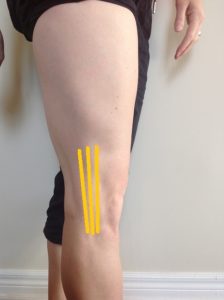IT Band Syndrome
Iliotibial band friction syndrome (IT Band Syndrome) is one of the most common injuries affecting long distance runners. When iliotibial band syndrome occurs (also known as iliotibial band friction syndrome or “IT band syndrome”) a part of the band can get irritated as it rubs against the femur (thigh bone) just above the knee. This can occur when certain biomechanical factors and tissue changes are subjected to repeated use, like that during endurance exercise.
IT Band Syndrome – Causes
There are many different opinions and ideas as to how and why iliotibial band syndrome occurs. In general, the majority of the literature suggests that the iliotibial band tissue is “frictioning” on the femur because the iliotibial band is taut against it. Given this, it is advisable to try and reduce the tension in the iliotibial band. Stretching is one option. Foam rolling is also gaining popularity as a method to try and reduce tension in various soft-tissues, although, to my knowledge, this approach is lacking scientific evidence (perhaps because it is relatively new). Unfortunately, stretching and foam-rolling as stand-alone remedies are unlikely to resolve iliotibial band syndrome.
Treatment for IT Band Syndrome
To effectively treat iliotibial band syndrome, our clinic combines some “homework” (as mentioned above) with targeted soft-tissue treatment such as active release technique and graston technique. These techniques have the ability to separate the iliotibial band from the underlying and surrounding tissues that may be adhered. Perhaps this is why stretching has limited effectiveness since it cannot adequately separate tissues or specifically target areas of adhesion. At Burlington Sports Therapy, active release technique and graston technique are performed by our chiropractors. We also have physiotherapists on staff who are able to treat iliotibial band syndrome.
Physiotherapy for IT Band Syndrome
According to the literature, weakness in certain hip flexor and gluteal muscles can be contributing factors in the development of iliotibial band friction syndrome. When this weakness is identified, the appropriate strengthening exercises are an important aspect of recovery. Consulting with a knowledgeable physiotherapist can assist you in this regard, providing you with the appropriate tools to prevent iliotibial band syndrome from recurring. Our physiotherapists also treat iliotibial band syndrome using laser therapy, soft tissue therapy and strengthening.
Unsure what to do? Give us a call; we can assist you. 905.220.7858. [email protected]
References:
Fredericson M, Wolf C. Iliotibial band syndrome in runners. Sports Medicine 2005; 35(5): 451-459.
Fredericson M, Cookingham CL, Chaudhari AM et al. Hip abductor weakness in distance runners with iliotibial band syndrome. Clinical Journal of Sports Medicine 2000; 10(3): 169-175.
Niemuth PE, Johnson RJ, Myers MJ, Thieman TJ. Hip muscle weakness and overuse injuries in recreational runners. Clinical Journal of Sports Medicine 2005; 15(1): 14-21.
Taunton JE, Ryan MB, Clement DB et al. A retrospective case-control analysis of 2002 running injuries. British Journal of Sports Medicine 2002; 36(2): 95-101.









